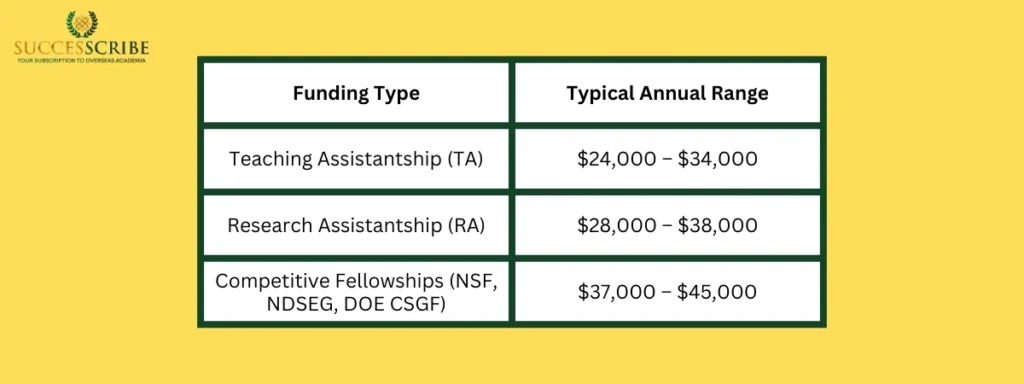Pursuing a PhD in Computer Science in USA represents one of the most prestigious and rewarding academic journeys available to aspiring researchers and technologists. The US hosts world-renowned universities that consistently rank among the top global institutions for computer science research and innovation. With the rapid advancement of artificial intelligence, machine learning, cybersecurity, and emerging technologies, the demand for highly qualified PhD graduates continues to grow across academia, industry, and government sectors.
Key Highlights – PhD in Computer Science in USA
- Overview of PhD in Computer Science in America
- Duration & Completion Rate of a PhD in Computer Science in the USA
- Top Universities for PhD in Computer Science in the USA
- Estimated Stipend & Salary for PhD Students in Computer Science in the USA
- GRE – Is It Still Required for CS PhD in the USA?
- Application Timeline & Process for PhD in Computer Science in the USA
- Top Reasons to Pursue a PhD in the USA?
- For International Students: Visas, Work, and Practicalities
- Conclusion
- FAQs
Want to Study in Europe?
Start your journey with Successcribe’s free expert guidance
Book a Free Session NowOverview of PhD in Computer Science in America
A PhD in Computer Science from the United States is widely regarded as the pinnacle of academic and research achievement in the field. It is designed for students who aim to push the boundaries of technology through original, impactful research, whether in Artificial Intelligence, Machine Learning, Data Science, Cybersecurity, Computer Vision, Human–Computer Interaction, Algorithms, or Systems Design.
Duration & Completion Rate of a PhD in Computer Science in the USA

The timeline for completing a PhD in Computer Science in USA is influenced by factors such as prior academic preparation, research complexity, and the student’s pace of progress.
Typical Duration
- Most students finish within 4 to 6 years.
- Students entering directly after a bachelor’s degree generally take closer to 5–6 years, as they spend additional time on coursework before transitioning fully into research.
- Those entering with a relevant master’s degree often complete their PhD in 4–5 years, as they can bypass some foundational requirements.
Program Milestones
- Years 1–2: Coursework, research rotations, and qualifying exams.
- Years 3–4: Intensive research, publication of papers, and dissertation proposal.
- Years 5–6: Final dissertation research, defense, and graduation.
Completion Rates
U.S. doctoral programs have an average completion rate of 57% within 10 years. Around 30% of students exit before completion, often due to changes in research interests or career paths. The remaining students may take longer due to the highly iterative nature of research and the challenges of publishing in top-tier conferences and journals.
Why Duration Varies:
- Complexity and scope of research topic.
- Faculty guidance and availability of resources.
- Time invested in publishing peer-reviewed papers (a key factor for competitive job markets).
- Part-time vs. full-time enrollment (rare but possible).
Top Universities for PhD in Computer Science in the USA
Top universities offering a PhD in Computer Science in USA are consistently ranked among the best in the world for research output. These universities are known for cutting-edge research, top faculty, excellent funding opportunities, and strong career outcomes.
| University | Ranking | Key Research Areas | Funding Options for PhD Students | Average Stipend (per year) |
| Massachusetts Institute of Technology (MIT) | #1 | AI, Machine Learning, Robotics, Cybersecurity, Systems, Theory of Computation | Full funding via RA, TA, and fellowships (e.g., NSF, Microsoft) | $45,000–$50,000 |
| Stanford University | #2 | AI, Natural Language Processing, Computer Vision, Databases, Systems & Networking | Full funding + industry-linked fellowships (Google, NVIDIA) | $47,000–$52,000 |
| Carnegie Mellon University (CMU) | #3 | AI, Robotics, Software Engineering, HCI, Cybersecurity | Full funding + industry research partnerships | $45,000–$50,000 |
| University of California, Berkeley (UC Berkeley) | #4 | Machine Learning, Databases, Programming Languages, Security, Quantum Computing | RA, TA, and major tech-industry fellowships | $44,000–$48,000 |
| Harvard University | #6 | AI Ethics, Machine Learning, Data Science, Theory, Systems | Fellowships, RA/TA, interdisciplinary grants | $45,000–$50,000 |
| University of Illinois Urbana-Champaign (UIUC) | #7 | High-Performance Computing, Cloud Systems, Networking, Security | RA/TA, fellowships, corporate sponsorships | $42,000–$46,000 |
| University of Washington (UW) | #8 | Computer Vision, NLP, HCI, Ubiquitous Computing, Systems | Full funding via RA, TA, and fellowships | $43,000–$47,000 |
| University of Michigan – Ann Arbor | #9 | Robotics, Cybersecurity, AI, Data Science | RA/TA, departmental fellowships, NSF funding | $42,000–$46,000 |
| Princeton University | #10 | Theoretical Computer Science, Cryptography, Machine Learning | Full funding via RA, TA, and fellowships | $44,000–$48,000 |
| Cornell University | #11 | Distributed Systems, Cloud Computing, Databases, AI, Security | RA/TA, fellowships, industry collaborations | $43,000–$47,000 |
Apply to Top European Universities
Make your application simple and stress-free with Successcribe
Get Expert Help NowEligibility & Admission Requirements for a PhD in Computer Science in the USA

Gaining admission to a PhD program in Computer Science in USA is highly competitive. Top universities look for candidates who not only have a strong academic foundation but also demonstrate clear research potential and alignment with faculty expertise.
1. Academic Background
- Bachelor’s Degree: Most universities accept direct applications from students with a Bachelor’s degree in Computer Science or a closely related field (e.g., Electrical Engineering, Mathematics, Data Science).
- Master’s Degree: While not mandatory, having a relevant Master’s degree can shorten the duration of the PhD and strengthen your application.
- GPA Requirements: Competitive programs often expect a minimum GPA of 3.2–3.5 (on a 4.0 scale). Elite universities (MIT, Stanford, Carnegie Mellon) generally admit candidates with GPAs of 3.7+.
2. Standardized Tests (GRE)
GRE Requirement Varies:
- Some universities (e.g., UT Austin) still require GRE scores.
- Many programs (e.g., University of Minnesota, Vanderbilt University) have made the GRE optional or waived it entirely.
Competitive Scores: For schools that require the GRE, aim for:
| Quantitative | 165+ |
| Verba | 155+ |
| Analytical Writing | 4.5+ |
3. English Language Proficiency (for international students)
If your prior education was not conducted in English, you’ll need to submit:
| IELTS | Overall score of 6.5–7.5 or higher |
| TOEFL iBT | 90–100 minimum (top schools may expect 105+). |
Some universities waive this requirement if you have studied in English for 2+ consecutive years at the undergraduate or graduate level.
4. Research Experience
- Strong preference is given to applicants with prior research exposure, through undergraduate research projects, internships, or publications in conferences/journals.
- Experience in presenting at workshops or contributing to open-source projects can significantly boost your profile.
5. Application Materials
A complete PhD application typically includes:
- Statement of Purpose (SOP): A compelling narrative detailing your academic journey, research interests, and reasons for pursuing a PhD at that specific institution.
- Curriculum Vitae (CV): Highlighting academic achievements, research work, technical skills, and any relevant professional experience.
- Letters of Recommendation: Usually three, preferably from professors or researchers who can attest to your research potential and academic capabilities.
- Academic Transcripts: From all post-secondary institutions attended.
- Research Proposal: Some universities ask for a short proposal outlining your intended area of research.
6. Faculty Alignment
Admission committees often look for a research match between the applicant’s interests and the expertise of faculty members. Mentioning specific professors whose work aligns with your goals can improve your chances of acceptance.
Estimated Stipend & Salary for PhD Students in Computer Science in the USA

One of the most attractive aspects of pursuing a PhD in Computer Science in the USA is that most programs offer full financial support. This means that admitted students typically receive:
- A tuition waiver (covering the full cost of tuition).
- A monthly stipend for living expenses.
- Health insurance coverage (often for both the student and dependents).
PhD Stipend (While Studying)
PhD stipends in Computer Science vary depending on the university, location, and whether the student is funded as a Teaching Assistant (TA), Research Assistant (RA), or through a fellowship.
| Funding Type | Typical Annual Range | Notes |
| Teaching Assistantship (TA) | $24,000 – $34,000 | Paid for teaching/lab duties, usually 15–20 hours/week |
| Research Assistantship (RA) | $28,000 – $38,000 | Funded by a faculty research grant; focus is on research work. |
| Competitive Fellowships (NSF, NDSEG, DOE CSGF) | $37,000 – $45,000 | Often include conference travel allowances and additional benefits. |
Example Stipends
- MIT: $45,000+ per year (including summer funding).
- University of California, Berkeley: $34,000–$36,000 per year depending on department appointment.
- University of Washington: $32,000 per year as a 50% RA/TA.
- University of Illinois Urbana–Champaign: $30,000–$33,000 per year depending on appointment.
Post-PhD Salary Prospects
Earning a PhD in Computer Science from a U.S. institution significantly increases earning potential, especially for those entering research-intensive careers.
| Career Path | Typical Salary Range (USD/year) | Notes |
| Tenure-Track Assistant Professor | $85,000 – $120,000 | Higher in well-funded private universities or top public institutions. |
| Industry Research Scientist | $140,000 – $170,000 | Includes positions at companies like Google, Microsoft, Meta, IBM, and NVIDIA. |
| Machine Learning/AI Specialist | $150,000 – $200,000+ | High demand in tech companies, finance, and healthcare. |
| Government/Defense Research Labs | $110,000 – $140,000 | Includes roles at NASA, National Labs, and DoD-affiliated institutions. |
GRE – Is It Still Required for CS PhD in the USA?

The GRE Landscape Has Shifted Dramatically
Over the past few years, many U.S. universities have either dropped the GRE requirement or made it optional, in favor of evaluating candidates more holistically. Key reasons include concerns about equity, the test’s limited predictive power for research success, and the logistical challenges highlighted during the pandemic.
- The University of Minnesota’s CS PhD programs, for example, no longer require or accept the GRE under any circumstances.
- Cornell’s CS PhD is fully GRE-free, with no option to even submit scores.
Specific Program Policies
| University / Department | GRE Status for CS PhD |
| UT Austin | Temporarily waived for Fall 2026; submitting scores is optional and can bolster an application. |
| UC San Diego (UCSD) | Not required for PhD and MS PhD for Fall 2026; no minimum score. |
| University of Illinois – Chicago (UIC) | Not required for Fall 2026; scores accepted if submitted. |
| Florida State University (FSU) | GRE required for now, but applicants can petition for a waiver starting Fall 2026 if certain GPA/funding criteria are met. |
| Others (e.g., Emory) | GRE is optional, meaning you may include it but it isn’t required. |
Application Timeline & Process for PhD in Computer Science in the USA
Applying for a PhD in Computer Science in the USA is a structured process that typically begins 12–18 months before your intended start date. Below is a step-by-step timeline and process to help you navigate it efficiently.
1. 12–18 Months Before Start Date: Research & Shortlisting
- Identify research interests: Narrow down your focus areas (e.g., Artificial Intelligence, Data Science, Cybersecurity, Human-Computer Interaction).
- Shortlist universities & faculty: Look for programs where faculty research aligns with your interests. Review their publications, lab work, and ongoing grants.
- Check eligibility & requirements: Different universities have varying prerequisites like GPA, GRE, TOEFL/IELTS, and recommendation letters.
2. 9–12 Months Before Start Date: Prepare Application Materials
- Statement of Purpose (SOP): Highlight research experience, academic achievements, and career goals.
- Recommendation Letters: Typically, 3 strong references from professors or research supervisors are required.
- Transcripts & Test Scores: Arrange official transcripts and take necessary standardized tests (GRE, TOEFL/IELTS, if applicable).
- Research Proposal (if required): Some universities ask for a brief research statement outlining your intended PhD direction.
3. 6–9 Months Before Start Date: Submit Applications
- Deadlines: Most fall admissions have deadlines between December and February of the previous academic year.
Example: For Fall 2026, apply between Dec 2025 – Feb 2026.
- Application Fees: Usually range from $75 to $125 per application.
- Online Submission: Upload all documents to the university portal. Ensure recommendations are submitted by referees before the deadline.
4. 3–6 Months Before Start Date: Interviews & Decisions
- Faculty Interviews: Shortlisted candidates may be invited for online or on-campus interviews to discuss research fit.
- Funding & Offers: Acceptance letters often include details of funding (research assistantships, teaching assistantships, fellowships).
- Decision Deadlines: Most offers must be accepted by April 15 for Fall intake (per the Council of Graduate Schools agreement).
5. 2–3 Months Before Start Date: Visa & Arrival Preparation
- I-20 Form: Issued by the university for your F-1 student visa application.
- Visa Interview: Schedule your visa appointment at the US Embassy/Consulate.
- Required documents: I-20, financial proof, admission letter, passport, DS-160 confirmation.
- Accommodation & Travel: Arrange housing and book flights well in advance.
Top Reasons to Pursue a PhD in the USA?
Pursuing a PhD in Computer Science in USA offers access to world-class research facilities, top-ranked universities, and unmatched opportunities for academic and industry collaboration.
1. Research ecosystem and funding culture
US CS departments operate within a dense research ecosystem: federally funded labs, industry-academic partnerships, open-source communities, and vibrant startup scenes. Many groups maintain long-running projects with continuous funding, enabling ambitious multi-year research agendas and access to cutting-edge compute, data, and instrumentation.
2. Breadth + depth training model
Most programs blend coursework breadth (systems, theory, AI/ML, HCI, security, programming languages, graphics/vision, data science) with depth in a specialization. You build foundational fluency before narrowing to a research focus guided by your advisor and committee.
3. Publishing culture and mentorship
Top US CS labs emphasize publishing at selective conferences and journals (e.g., NeurIPS, ICML, CVPR, SIGCOMM, SOSP/OSDI, PLDI, POPL, CHI, STOC/FOCS, S&P/USENIX Security). You’ll learn to ideate, prototype, experiment, write, and present at a professional level, with multi-advisor or multi-institution collaborations being common.
4. Career pathways
Graduates pursue tenure-track academia, industrial research labs (FAANG-style, semiconductor, cloud, enterprise, biotech), high-growth startups, research-engineering hybrid roles, policy/standards organizations, and public-interest tech. A US PhD can be a strong platform for global mobility.
For International Students: Visas, Work, and Practicalities
Studying for a PhD in Computer Science in USA as an international student comes with some extra steps, but once you understand them, the process becomes much smoother. Here’s what you need to know:
- Student Visa
- F-1 Visa – This is the most common visa for PhD students.
- Once you get your admission and funding offer, your university will send you an I-20 form. You’ll use this to apply for the F-1 visa at a US embassy or consulate.
- The visa allows you to study full-time and work in certain situations (explained below).
Keep your passport, visa, and I-20 valid throughout your studies. If you plan to travel outside the US during your PhD, make sure your I-20 is signed for travel by your international student office.
Conclusion
In the USA, a PhD in Computer Science is more than a degree, it’s an entry ticket to the top 2% of tech innovators and researchers worldwide. With over 4,000 universities but only a select few making it to the global top ranks, competition is fierce and opportunities are immense. Graduates often secure roles with salaries exceeding $120,000 per year, join elite research labs, or launch startups that redefine industries. Pursuing a PhD in Computer Science in USA is an investment of time, intellect, and passion, but the rewards in research, recognition, and salary are unmatched.
FAQs
How important are publications before applying?
Helpful but not strictly required. Strong evidence of research potential, well-executed projects, clear letters, and a thoughtful SoP, can offset missing publications. Even workshop/demo papers or high-quality preprints help.
Can I switch research areas during the PhD?
Yes, within reason. Early years are most flexible. Switching advisors is possible but requires careful planning and funding coordination.
How many applications should I submit?
Many candidates apply to 6–10 programs across reach, match, and safety tiers. Focus on genuine research fit rather than sheer quantity.
What if I don’t find an advisor match after joining?
Use rotations or trial projects, talk to the graduate director, and seek co-advising options. Programs want you to succeed; proactive communication is key.
Related Post
STEM full form and Courses List
Highest paid engineer in the world
Best medical courses in the world
Jobs and salary after MBA in UK














